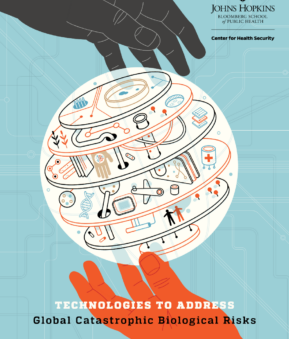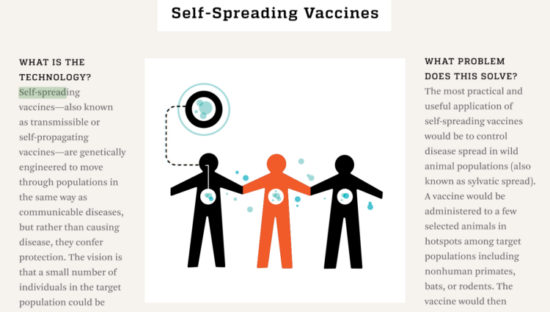2 April 2022 | Video (CC EN) | In the first article on the global pandemic treaty of the World Health Organization, I found fears largely confirmed that the WHO could become a health-supergovernment and establish a permanent pandemic regime. Another worry I had found expressed was that it could be used to further the transhumanist agenda of the World Economic Forum. Unfortunately, a search of semi-official sources revealed that such warnings are warranted.
The U.S. organization Children’s Health Defense warns that the pandemic treaty will also serve to implement the transhumanist vision of Klaus Schwab, head of the World Economic Forum. This vision consists, in Schwabs words, of “a range of new technologies that are fusing the physical, digital and biological worlds, impacting all disciplines, economies and industries, and even challenging ideas about what it means to be human.” One of the ways this will be implemented, the organization warns, is through constant, no-cause testing for viruses of all kinds and regular injections of gene-modified substances to boost immune defenses. Once this quasi-obligatory intervention in the body has become routine, more drastic interventions could follow.
On the nature of transhumanism
What the global pandemic treaty between WHO and all its member governments, to be negotiated until 2024, is all about, I have already illuminated on the basis of (predominantly) official sources. Before we now take a look at semi-official sources, a few words on the nature of transhumanism are useful. Bernd Schoepe recently wrote about it aptly on this blog (in German):
“At the level of global governance, transhumanism is playing an increasingly important role in the projects and plans of today’s power elites. A new image of humanity is supposed to help create a resilient form of globalization in which individual freedoms can be restricted or suspended out of “higher necessity.” Transhumanism, which assumes that human nature with its weaknesses can and must be overcome, offers a world-saving program with fantastic-sounding solutions, with the help of computer, nano and biotechnology – at the price of a continuous datafication and total controllability of the population.”
The transhumanist views humanity from the same perspective from which a farmer, dilligently concerned about the health and prosperity of his cattle or sheep, views his flock. Just as the farmer does not serve his flock, the transhumanist does not serve a people he views as sovereign, composed of free, self-responsible human beings. Rather, he manages and optimizes populations as the farmer manages a herd. If the ideas of Klaus Schwab and the World Economic Forum materialize, all people will be connected to the Internet of Bodies, which they never seize to promote.
So let’s start looking for sources with this understanding of transhumanism.
Herd immunity by infectious vaccines
We quickly come across the quintessence of herd management: vaccinating everyone against infectious diseases without requiring consent and without the possibility to opt out. The keyword is self-spreading vaccines. On March 18, 2022 an article appeared in National Geographic about “The controversial quest to make a ‘contagious’ vaccine.” In Science magazine one could read a critical article on “Eroding norms for release of for releasing self-spreading viruses” in January 2022.
These articles are about genetically modified viruses that are supposed to infect as many members of a species as possible without making them seriously ill. At the same time, these harmless viruses, for example certain herpes viruses, are supposed to spread fragments of a dangerous virus with their manipulated genetic material. The bodies of those infected are thereby triggered to produce antibodies against this dangerous virus. This has already been tested in field trials to vaccinate animal species that serve as reservoirs for a virus that is dangerous to humans.
The authors of the article in Science emphasize that the know-how has been around for more than 20 years, but that scientists have largely agreed that this kind of manipulation of nature is too dangerous – partly because the viruses can mutate too easily in unforeseen ways. But in recent years, the authors criticize, some research groups have simply defied this consensus and continue to push forward with this research and experimentation.
Following the literature references and supplementing them with a search engine search, it quickly becomes clear who the organizations are that are pushing this questionable technology – and not just as a method of vaccinating animals, but even as a means to forcibly vaccinate humans.
The first organization I come across is the Center for Health Security at Johns Hopkins University in the US. TThis institution, founded with money from the Rockefeller Foundation, is extremely rich in money and influence, it is worth looking back to the early phase of the Corona pandemic (source in German). On January 17, 2020, just before the annual meeting of the World Economic Forum in Davos and after the world had just begun to take an interest in the new virus discovered in China, the Center for Health Security, along with the World Economic Forum (WEF) and the Gates Foundation, issued a joint press release.
It presented the evaluation of the table-exercise “Event 201,” particularly the policy recommendations that had been agreed upon three months earlier. The exercise had involved CEOs, experts and officials acting out a coronavirus pandemic in October 2019. The January 2020 memo urged, among other things,” an unprecedented level of cooperation between governments, international organizations, and private companies” in the event of a pandemic, and a rigid crackdown on “fake news”, particularly through “flooding” of the information zone. It further recommended an easing of regulations on vaccine development.
We can see, that what Johns Hopkins, Gates and WEF propose has a good chance of being implemented. While the WEF was still meeting in Davos, the Johns Hopkins Center for Health Security launched its Corona Dashboard on January 22, 2020, with its dramatically rising and seemingly precise figures. It captivated journalists and media consumers all over the world for months and laid the groundwork for extremely rigid, unprecedented pandemic containment measures.
WHO cooperates very closely and in multiple ways with Johns Hopkins, Gates Foundation, Rockefeller Foundation, CEPI, World Economic Forum, and other organizations involved, and depends heavily on their financial grants.
Johns Hopkins University gives guidance
In October 2018 a team of the Center for Health Security published the brochure “Technologies to address global catastrophic biological risks.”

Among the 15 new technologies for pandemic defense and response that the authors advertise are genetically engineered viruses for vaccine dissemination, both in animals and directly in humans. Unlike the critics in the Science article, who claim to speak for the long-standing consensus of the scientific community, the team from the Center of Health Security claims that using self-spreading vaccines in animal populations is a largely mature and relatively unproblematic technology. They describe it as having high impact and being almost ready for field use. Regarding application in humans, they write:
“In the event of a grave public health threat, self-spreading vaccines could potentially be used to broadly inoculate human populations. (…) For human use, targeted release of weakly transmissible self-spreading vaccine early in an outbreak could create herd immunity in communities and prevent an outbreak from becoming a pandemic. If introduced later, after an outbreak has become widespread, self-spreading vaccines could still help to protect susceptible individuals and limit the number of new cases and prevent catastrophic outcomes.”

Regarding use in humans, it is conceded that this is very problematic with regard to the consent requirement that normally applies. But that was in 2018. By 2022, vaccination mandates have already been issued in many jurisdictions.
The technology, on which such circles are working, is perfidious not only because it can be used to vaccinate people without consent, but also, because it is so hard to control, how it is used by whom. Once developed, self-spreading vaccines are very easy to release in different places. Who then is to find out and prove who did it.
Foundations and intelligence agencies as drivers
Conveniently, the Johns Hopkins brochure lists the institutions working on the new herd control and herd health technologies it advertises. The list does little to instill confidence that democratic control and fundamental rights will play a significant role in the application of these technologies.
First, there is CEPI, the Coalition for Epidemic Preparedness Innovations. Founded in 2017 as a public-private partnership with seed funding from the Gates Foundation, the organization writes about itself: “CEPI was founded in Davos by the governments of Norway and India, the Bill & Melinda Gates Foundation, Wellcome, and the World Economic Forum.”

Then there is the biotechnology office of the Defense Advanced Research Projects Agency (DARPA). DARPA is a research and development agency for technologies with direct or indirect utility to U.S. military in a very broad sense. It is reporting to the Department of Defense . The agency assists private companies in developing technologies of military interest.
In addition, In-Q-Tel, something like the intelligence community’s equivalent of DARPA, is active in the field, the brochure says.
There is also the Intelligence Advanced Research Projects Activity (IARPA). This is an organization that reports to the Office of the Director of National Intelligence. IARPA is responsible for managing research projects “of high risk, high reward.”
And finally, there is the Global Health Technologies Coalition. This is a lobbying organization founded by the Bill & Melinda Gates Foundation for the promotion of new health technologies in public-private partnerships, i.e. by private companies with public subsidies.
In the acknowledgements of the Johns Hopkins brochure, you even learn that Dylan George of In-Q-Tel and IARPA Director Jason Matheny “read and commented on the report in its entirety” before publication. With this list of institutions and control-reading individuals involved in this research, one is no longer surprised at the strong focus on surveillance.
Surveillance is key
In my first piece on the pandemic treaty, the strong emphasis on early detection of actual or potential health threats became clear. The brochure from Johns Hopkins University could easily be the template. Here is a small excerpt:
“A number of emerging technologies and methodologies focus on improving infectious disease surveillance, and situational awareness generally, with specific attention to early detection. Often referred to as digital disease detection or digital epidemiology, these methods rely on novel sources of surveillance data, including genomic sequencing and sensing, social media and internet search logs, satellite imagery, or over-the-counter drugstore transaction data.”
To protect us, they want to put us under total survellance, even down to what we do and say on social media. I recently described how active the WHO itself has become in this field in recent years in my blogpost on “Infodemiology” (in German).
And it gets even wilder: A network of land-, sea- and airborne drones equipped with sensors and imaging equipment could be “used to track population activity and movement,” among other things. In addition, sensors will “examine diverse substrates and environments for known or new contaminants, strains or phenotypes.” And further:
“Genomic sensing systems could be established that would continually monitor the air, water, soil, transportation hubs, mass gatherings, farms, and other microenvironments relevant to pathogen transmission. (…) Recent proposals have included sequencing the contents of airline lavatories, hospital laundries, municipal sewage systems, and air-handling systems to detect the presence of high-consequence pathogens, possibly providing advance warning of an impending biological event.”
It is almost certain that such a total surveillance system will sound the alarm quite frequently – at least if those who set the thresholds want it to. So far, no one has ever noticed new viruses that soon disappeared. In the future, alarms will sound every time and measures are taken, if the WHO, Johns Hopkins Univ and the U.S. securtity apparatus have their way.
And what happens when the surveillance technology causes an alarm? Then there will be another authoritarian crackdown on civil liberties, as we know them only too well by now:
“Surveillance technologies should provide sufficiently compelling evidence to convince epidemiologists, public health practitioners, and political leaders to launch a timely and robust response.”
Conveniently for those pursuing this strategy, it will look at the more necessary and the more successful, the more frequently it sounds a wrong alarm about a novel virus, that would have disappeared by itself again.
Technologies for herd health
Most of of the other new technologies advertized in the brochure also fall into the category of facilitating centrally organized herd management, with as little need for personnel and as little independent decision-making by individuals as possible, while maximizing profit opportunities for corporations and their owners.
By way of an example: The health experts at Johns Hopkins do not recommend building up and maintaining reserve capacities in the health sector to cope with possible pandemics. This would be difficult to organize under private-sector, profit-oriented management. The government would be needed to subsidize excess capacities and then would probably want to interfere. More doctors and nurses and more beds would run counter the “improved cost efficiency and cost-effectiveness” as the brochure expresses it. Instead, they recommend robots and telemedicine to dispense with the need for human reserve capacities. In a pandemic, people should then seek medical help digitally from home, preferably by programs, and medication provided by drones if needed. “Work-intesive health services such as intravenous fluid delivery and medication” they should get from specialized robots at dedicated stations.
Using vaccine patches (MP) or ingestible capsules containing vaccine bacteria, the “implementation of mass vaccinations.” would be “modernized”. This could significantly reduce the “time needed to fully vaccinate a population”.
The strategy of constant, global mass testing would be underpinned by the use of test papers with diagnostic fluids, which are very cheap. With these – and drones if needed – daily testing of all people should then become possible, both financially and logistically.
The authors envision fleets of drones to deliver vaccines and drugs to areas with infectious outbreaks without human suppliers. Presumably the same fleets of drones would be used to do al the surveillance of people and their movements, described before. The brochure proposes a consortium of technology developers, health practitioners, and policy makers to advance these technologies with due priority and help them become reality. I am sure, the experts from the World Economic Forum, the IT- and the pharmaceutical sector and their foundations would be more than willing to participate.
If a global treaty on prevention and management of pandemics will require all governments to make use of the prevention and containment-measures, that this consortium develops, the gate into a transhumanist future will be wide open.
